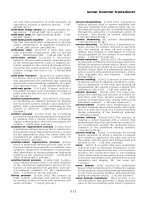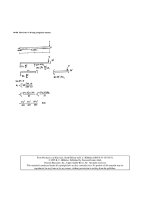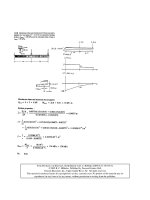Engineering Mechanics - Statics Episode 3 Part 2 pdf
Bạn đang xem bản rút gọn của tài liệu. Xem và tải ngay bản đầy đủ của tài liệu tại đây (530.52 KB, 40 trang )
Engineering Mechanics - Statics Chapter 8
Frictional Forces on Screw: Here
θ
atan
h
2
π
d
2
⎛
⎜
⎝
⎞
⎟
⎠
⎡
⎢
⎢
⎣
⎤
⎥
⎥
⎦
=
θ
6.06 deg=
φ
s
atan
μ
s
()
=
φ
s
16.70 deg=
Applying Eq.8-3, we have
MP
d
2
⎛
⎜
⎝
⎞
⎟
⎠
tan
θφ
s
+
()
=
P 2
M
d tan
θφ
s
+
()
⎛
⎜
⎝
⎞
⎟
⎠
= P 127.15 N=
Note since
φ
s
16.70 deg=
>
θ
6.06 deg=
, the screw is self-locking. It will not unscrew even if the
moment M is removed.
Equations of Equilibrium and Friction:
Σ
M
c
= 0;
c
b
2
c
2
+
⎛
⎜
⎝
⎞
⎟
⎠
Pb F
E
cos
β
()
b− F
E
sin
β
()
a− 0=
841
© 2007 R. C. Hibbeler. Published by Pearson Education, Inc., Upper Saddle River, NJ. All rights reserved.
This material is protected under all copyright laws as they currently exist. No portion of this material may
be reproduced, in any form or by any means, without permission in writing from the publisher.
Engineering Mechanics - Statics Chapter 8
F
E
Pcb
b
2
c
2
+ cos
β
()
b sin
β
()
a+
()
= F
E
72.7 N=
The equilibrium of clamped block requires that
F
D
F
E
= F
D
72.7 N=
Problem 8-82
The clamp provides pressure from several directions on the edges of the board. If the
square-threaded screw has a lead h, radius r, and the coefficient of static friction is
μ
s
, determine
the horizontal force developed on the board at A and the vertical forces developed at B and C if a
torque
M
is applied to the handle to tighten it further. The blocks at B and C are pin-connected to
the board.
Given:
h 3mm=
r 10 mm=
μ
s
0.4=
M 1.5 N m⋅=
β
45 deg=
Solution:
φ
s
atan
μ
s
()
=
φ
s
21.801 deg=
θ
atan
h
2
π
r
⎛
⎜
⎝
⎞
⎟
⎠
=
θ
2.734 deg=
MA
x
rtan
φ
s
θ
+
()
= A
x
M
r tan
φ
s
θ
+
()
= A
x
329 N=
+
→
Σ
F
x
= 0;
A
x
2Tcos
β
()
− 0= T
1
2
A
x
cos
β
()
⎛
⎜
⎝
⎞
⎟
⎠
= T 232.36 N=
C
y
Tsin
β
()
= B
y
C
y
=
B
y
C
y
⎛
⎜
⎝
⎞
⎟
⎠
164.3
164.3
⎛
⎜
⎝
⎞
⎟
⎠
N=
842
© 2007 R. C. Hibbeler. Published by Pearson Education, Inc., Upper Saddle River, NJ. All rights reserved.
This material is protected under all copyright laws as they currently exist. No portion of this material may
be reproduced, in any form or by any means, without permission in writing from the publisher.
Engineering Mechanics - Statics Chapter 8
Problem 8-83
The two blocks under the double wedge are brought together using a left and right
square-threaded screw. If the mean diameter is d, the lead is r
l
, and the coefficient of static
friction is
μ
s
, determine the torque needed to draw the blocks together. The coefficient
of static friction between each block and its surfaces of contact is
μ
'
s
.
Units Used:
kN 10
3
N=
Given:
F 5kN=
θ
20 deg=
d 20 mm=
r
l
5mm=
μ
s
0.4=
μ
'
s
0.4=
Solution:
Top block:
F− 2N
1
cos
θ
()
+ 2
μ
'
s
N
1
sin
θ
()
− 0=
N
1
F
2 cos
θ
()
μ
'
s
sin
θ
()
−
()
=
N
1
3.1138 kN=
Bottom block:
N' N
1
cos
θ
()
−
μ
'
s
N
1
sin
θ
()
+ 0=
N' N
1
cos
θ
()
μ
'
s
N
1
sin
θ
()
−=
N' 2.50 kN=
N
1
− sin
θ
()
μ
'
s
N
1
cos
θ
()
− T+
μ
'
s
N'− 0=
TN
1
sin
θ
()
μ
'
s
N
1
cos
θ
()
+
μ
'
s
N'+=
T 3.2354kN=
843
© 2007 R. C. Hibbeler. Published by Pearson Education, Inc., Upper Saddle River, NJ. All rights reserved.
This material is protected under all copyright laws as they currently exist. No portion of this material may
be reproduced, in any form or by any means, without permission in writing from the publisher.
Engineering Mechanics - Statics Chapter 8
φ
atan
μ
s
()
=
φ
21.80 deg=
θ
atan
r
l
πd
⎛
⎜
⎝
⎞
⎟
⎠
=
θ
4.55 deg=
Since there are two blocks,
M 2T
d
2
tan
θφ
+
()
= M 32N m⋅=
Problem 8-84
The two blocks under the double wedge are brought together using a left and right
square-threaded screw. If the mean diameter is d, the lead is r
l
, and the coefficient of static
friction is
μ
s
, determine the torque needed to spread the blocks apart. The coefficient
of static friction between each block and its surfaces of contact is
μ
'
s
.
Units Used:
kN 10
3
N=
Given:
F 5kN=
θ
20 deg=
d 20 mm=
r
l
5mm=
μ
s
0.4=
μ
'
s
0.4=
Solution:
Top block:
F− 2N
1
cos
θ
()
+ 2
μ
'
s
N
1
sin
θ
()
+ 0=
N
1
F
2 cos
θ
()
μ
'
s
sin
θ
()
+
()
=
N
1
2.3223 kN=
844
© 2007 R. C. Hibbeler. Published by Pearson Education, Inc., Upper Saddle River, NJ. All rights reserved.
This material is protected under all copyright laws as they currently exist. No portion of this material may
be reproduced, in any form or by any means, without permission in writing from the publisher.
Engineering Mechanics - Statics Chapter 8
Bottom block :
N' N
1
cos
θ
()
−
μ
'
s
N
1
sin
θ
()
− 0=
N' N
1
cos
θ
()
μ
'
s
N
1
sin
θ
()
+=
N' 2.50 kN=
N
1
− sin
θ
()
μ
'
s
N
1
cos
θ
()
+ T−
μ
'
s
N'+ 0=
TN
1
− sin
θ
()
μ
'
s
N
1
cos
θ
()
+
μ
'
s
N'+=
T 1.0786kN=
φ
atan
μ
s
()
=
φ
21.80 deg=
θ
atan
r
l
π
d
⎛
⎜
⎝
⎞
⎟
⎠
=
θ
4.55 deg=
Since there are two blocks,
M 2T
d
2
tan
φθ
−
()
= M 6.7 N m⋅=
Problem 8-85
The cord supporting the cylinder of mass M passes around three pegs, A, B, C, where the
coefficient of friction is
μ
s
.
Determine the range of values for the magnitude of the horizontal
force
P
for which the cylinder will not move up or down.
Given:
M 6kg=
θ
45 deg=
μ
s
0.2=
g 9.81
m
s
2
=
Solution:
Total angle
β
5
2
π
4
θ
−=
β
270.00 deg=
845
© 2007 R. C. Hibbeler. Published by Pearson Education, Inc., Upper Saddle River, NJ. All rights reserved.
This material is protected under all copyright laws as they currently exist. No portion of this material may
be reproduced, in any form or by any means, without permission in writing from the publisher.
Engineering Mechanics - Statics Chapter 8
Forces P
min
Mge
μ
s
−
β
= P
max
Mge
μ
s
β
=
Answer
P
min
15.9 N=
< P <
P
max
217.4 N=
Problem 8-86
The truck, which has mass m
t
, is to be lowered down the slope by a rope that is wrapped around
a tree. If the wheels are free to roll and the man at A can resist a pull P, determine the minimum
number of turns the rope should be wrapped around the tree to lower the truck at a constant
speed. The coefficient of kinetic friction between the tree and rope is
μ
k
.
Units Used:
Mg 1000 kg=
Given:
m
t
3.4 Mg=
P 300 N=
θ
20 deg=
μ
k
0.3=
g 9.81
m
s
2
=
Solution:
Σ
F
x
= 0;
T
2
m
t
gsin
θ
()
− 0= T
2
m
t
gsin
θ
()
= T
2
11407.74 N=
T
2
Pe
μ
k
β
=
β
ln
T
2
P
⎛
⎜
⎝
⎞
⎟
⎠
μ
k
=
β
694.86 deg=
Use
ceil
β
360 deg
⎛
⎜
⎝
⎞
⎟
⎠
2.00=
turns
846
© 2007 R. C. Hibbeler. Published by Pearson Education, Inc., Upper Saddle River, NJ. All rights reserved.
This material is protected under all copyright laws as they currently exist. No portion of this material may
be reproduced, in any form or by any means, without permission in writing from the publisher.
Engineering Mechanics - Statics Chapter 8
Problem 8-87
The wheel is subjected to a torque
M
. If
the coefficient of kinetic friction
between the band brake and the rim of
the wheel is
μ
k
,
determine the smallest
horizontal force
P
that must be applied
to the lever to stop the wheel.
Given:
a 400 mm= d 25 mm=
b 100 mm= r 150 mm=
c 50 mm= M 50 N m⋅=
μ
k
0.3=
Solution:
Initial guesses:
T
1
5N= T
2
10 N=
Given
Wheel:
Σ
M
0
= 0;
T
2
− rT
1
r+ M+ 0= T
2
T
1
e
μ
k
3
π
2
⎛
⎜
⎝
⎞
⎟
⎠
=
T
1
T
2
⎛
⎜
⎝
⎞
⎟
⎠
Find T
1
T
2
,
()
= T
1
54.66 N=
Link:
Σ
M
B
= 0;
T
1
cFd− 0= FT
1
c
d
⎛
⎜
⎝
⎞
⎟
⎠
= F 109.32 N=
Lever:
Σ
M
A
= 0;
P− aFb+ 0= PF
b
a
⎛
⎜
⎝
⎞
⎟
⎠
= P 27.3 N=
Problem 8-88
A cylinder A has a mass M. Determine the smallest force
P
applied to the handle of the lever
required for equilibrium. The coefficient of static friction between the belt and the wheel is
μ
s
.
The drum is pin connected at its center, B.
847
© 2007 R. C. Hibbeler. Published by Pearson Education, Inc., Upper Saddle River, NJ. All rights reserved.
This material is protected under all copyright laws as they currently exist. No portion of this material may
be reproduced, in any form or by any means, without permission in writing from the publisher.
Engineering Mechanics - Statics Chapter 8
Given:
M 75 kg=
a 700 mm=
b 25 mm=
c 300 mm=
d 200 mm=
e
1
60 mm=
μ
s
0.3=
e 2.718=
Solution:
Initial guesses:
T
1
1N= T
2
1N= P 1N=
Given
Drum:
T
2
T
1
e
μ
s
3
π
2
⎛
⎜
⎝
⎞
⎟
⎠
=
T
2
− cT
1
c+ Mgd+ 0=
Lever:
T
1
− e
1
T
2
b+ Pa− 0=
T
1
T
2
P
⎛
⎜
⎜
⎜
⎝
⎞
⎟
⎟
⎟
⎠
Find T
1
T
2
, P,
()
=
T
1
T
2
⎛
⎜
⎝
⎞
⎟
⎠
157.7
648.2
⎛
⎜
⎝
⎞
⎟
⎠
N= P 9.63 N=
Problem 8-89
Determine the largest mass of cylinder A that can be supported from the drum if a force
P
is
applied to the handle of the lever. The coefficient of static friction between the belt and the
wheel is
μ
s
. The drum is pin supported at its center, B.
Given:
P 20 N=
848
© 2007 R. C. Hibbeler. Published by Pearson Education, Inc., Upper Saddle River, NJ. All rights reserved.
This material is protected under all copyright laws as they currently exist. No portion of this material may
be reproduced, in any form or by any means, without permission in writing from the publisher.
Engineering Mechanics - Statics Chapter 8
a 700 mm=
b 25 mm=
c 300 mm=
d 200 mm=
e
1
60 mm=
μ
s
0.3=
e 2.718=
Solution:
Initial guesses:
T
1
1N= T
2
1N= M 1kg=
Given
Drum:
T
2
T
1
e
μ
s
3
π
2
⎛
⎜
⎝
⎞
⎟
⎠
=
T
2
− cT
1
c+ Mgd+ 0=
Lever:
T
1
− e
1
T
2
b+ Pa− 0=
T
1
T
2
M
⎛
⎜
⎜
⎜
⎝
⎞
⎟
⎟
⎟
⎠
Find T
1
T
2
, M,
()
=
T
1
T
2
⎛
⎜
⎝
⎞
⎟
⎠
327.4
1.3 10
3
×
⎛
⎜
⎝
⎞
⎟
⎠
N= M 155.7 kg=
Problem 8-90
The uniform bar AB is supported by a rope that passes over a frictionless pulley at C and a
fixed peg at D. If the coefficient of static friction between the rope and the peg is
μ
D
,
determine the smallest distance x from the end of the bar at which a force
F
may be placed
and not cause the bar to move.
Given:
F 20 N= a 1m=
849
© 2007 R. C. Hibbeler. Published by Pearson Education, Inc., Upper Saddle River, NJ. All rights reserved.
This material is protected under all copyright laws as they currently exist. No portion of this material may
be reproduced, in any form or by any means, without permission in writing from the publisher.
Engineering Mechanics - Statics Chapter 8
μ
D
0.3=
Solution:
Initial guesses:
T
A
5N= T
B
10 N= x 10 m=
Given
Σ
M
A
= 0;
F− xT
B
a+ 0=
Σ
F
y
= 0;
T
A
T
B
+ F− 0=
T
A
T
B
e
μ
D
π
2
⎛
⎜
⎝
⎞
⎟
⎠
=
T
A
T
B
x
⎛
⎜
⎜
⎜
⎝
⎞
⎟
⎟
⎟
⎠
Find T
A
T
B
, x,
()
=
x 0.38 m=
Problem 8-91
Determine the smallest lever force
P
needed to prevent the wheel from rotating if it is subjected
to a torque
M
. The coefficient of static friction between the belt and the wheel is
μ
s
. The wheel
is pin-connected at its center, B.
Given:
M 250 N m=
μ
s
0.3=
r 400 mm=
a 200 mm=
b 750 mm=
Solution:
Σ
M
A
= 0;
F− aPab+()+ 0=
850
© 2007 R. C. Hibbeler. Published by Pearson Education, Inc., Upper Saddle River, NJ. All rights reserved.
This material is protected under all copyright laws as they currently exist. No portion of this material may
be reproduced, in any form or by any means, without permission in writing from the publisher.
Engineering Mechanics - Statics Chapter 8
FP
ab+
a
⎛
⎜
⎝
⎞
⎟
⎠
=
β
3
π
2
=
F' F e
μ
s
β
=
Σ
M
B
= 0;
P−
ab+
a
⎛
⎜
⎝
⎞
⎟
⎠
e
μ
s
β
rM+ P
ab+
a
⎛
⎜
⎝
⎞
⎟
⎠
r+ 0=
P
Ma
ab+()re
μ
s
β
1−
()
= P 42.3 N=
Problem 8-92
Determine the torque M that can be resisted by the band brake if a force
P
is applied to the
handle of the lever. The coefficient of static friction between the belt and the wheel is
μ
s
. The
wheel is pin-connected at its center, B.
Given:
P 30 N=
μ
s
0.3=
r 400 mm=
a 200 mm=
b 750 mm=
Solution:
Σ
M
A
= 0;
F− aPab+()+ 0=
FP
ab+
a
⎛
⎜
⎝
⎞
⎟
⎠
= F 142.5 N=
F' F e
μ
s
3
π
2
= F' 585.8 N=
851
© 2007 R. C. Hibbeler. Published by Pearson Education, Inc., Upper Saddle River, NJ. All rights reserved.
This material is protected under all copyright laws as they currently exist. No portion of this material may
be reproduced, in any form or by any means, without permission in writing from the publisher.
Engineering Mechanics - Statics Chapter 8
Σ
M
B
= 0;
F'− rFr+ M+ 0=
MF'rFr−= M 177N m⋅=
Problem 8-93
Blocks A and B weigh W
A
and W
B
and respectively. Using the coefficients of static friction indicated,
determine the greatest weight of block D without causing motion.
Given:
W
A
50 lb=
W
B
30 lb=
μ
0.5=
μ
BA
0.6=
μ
AC
0.4=
θ
20 deg=
Assume that B slips on A, but A does not move.
Guesses W
D
1lb= T
B
1lb=
N
B
1lb= N
C
1lb= F
C
1lb=
Given W
D
T
B
e
μ
π
2
=
T
B
− F
C
+ 0=
N
C
W
A
− W
B
− 0=
T
B
−
μ
BA
N
B
cos
θ
()
+ N
B
sin
θ
()
− 0=
N
B
cos
θ
()
μ
BA
N
B
sin
θ
()
+ W
B
− 0=
852
© 2007 R. C. Hibbeler. Published by Pearson Education, Inc., Upper Saddle River, NJ. All rights reserved.
This material is protected under all copyright laws as they currently exist. No portion of this material may
be reproduced, in any form or by any means, without permission in writing from the publisher.
Engineering Mechanics - Statics Chapter 8
W
D
T
B
N
B
N
C
F
C
⎛
⎜
⎜
⎜
⎜
⎜
⎜
⎝
⎞
⎟
⎟
⎟
⎟
⎟
⎟
⎠
Find W
D
T
B
, N
B
, N
C
, F
C
,
()
=
W
D
T
B
N
B
N
C
F
C
⎛
⎜
⎜
⎜
⎜
⎜
⎜
⎝
⎞
⎟
⎟
⎟
⎟
⎟
⎟
⎠
12.75
5.81
26.20
80.00
5.81
⎛
⎜
⎜
⎜
⎜
⎜
⎝
⎞
⎟
⎟
⎟
⎟
⎟
⎠
lb=
Now check the assumption that A does not move
F
Cmax
μ
AC
N
C
= F
Cmax
32.00 lb=
Since
F
C
5.81 lb=
<
F
Cmax
32.00 lb=
then our assumption is good.
W
D
12.75 lb=
Problem 8-94
Blocks A and B have weight W, and D weighs W
D
. Using the coefficients of static
friction indicated, determine the frictional force between blocks A and B and between
block A and the floor C.
Given:
W 75 lb=
μ
BA
0.6=
W
D
30 lb=
μ
AC
0.4=
μ
0.5=
θ
20 deg=
Solution:
W
D
T
B
e
μ
π
2
= T
B
W
D
e
1
2
μπ
= T
B
13.679 lb=
F
C
T
B
= F
C
13.68 lb=
Check N
C
2W− 0= N
C
2W= N
C
150.00 lb=
F
Cmax
μ
AC
N
C
= F
Cmax
60.00 lb=
Since
F
C
13.68 lb=
<
F
Cmax
60.00 lb=
then the system does not slip at C.
853
© 2007 R. C. Hibbeler. Published by Pearson Education, Inc., Upper Saddle River, NJ. All rights reserved.
This material is protected under all copyright laws as they currently exist. No portion of this material may
be reproduced, in any form or by any means, without permission in writing from the publisher.
Engineering Mechanics - Statics Chapter 8
For block B:
The initial guessess:
N
B
1lb= F
B
1lb=
Given
+
↑
Σ
F
y
= 0;
N
B
cos
θ
()
F
B
sin
θ
()
+ W− 0=
+
→
Σ
F
x
= 0;
F
B
cos
θ
()
N
B
sin
θ
()
− T
B
− 0=
N
B
F
B
⎛
⎜
⎝
⎞
⎟
⎠
Find N
B
F
B
,
()
= N
B
65.80 lb= F
B
38.51 lb=
Check
F
Bmax
μ
BA
N
B
= F
Bmax
39.48 lb=
Since
F
B
38.51 lb=
<
F
Bmax
39.48 lb=
then no slipping occurs between the blocks
Problem 8-95
Show that the frictional relationship between the belt tensions, the coefficient of friction
μ
,
and the
angular contacts
α
and
β
for the V-belt is T
2
=T
1
e
μβ/
sin(
α
/2)
when the belt is on the verge of slipping.
Solution:
FBD of a section of the belt is shown.
Proceeding in the general manner:
T dT+()− cos
d
θ
2
⎛
⎜
⎝
⎞
⎟
⎠
Tcos
d
θ
2
⎛
⎜
⎝
⎞
⎟
⎠
+ 2
μ
dN+ 0=
Σ
F
x
= 0;
854
© 2007 R. C. Hibbeler. Published by Pearson Education, Inc., Upper Saddle River, NJ. All rights reserved.
This material is protected under all copyright laws as they currently exist. No portion of this material may
be reproduced, in any form or by any means, without permission in writing from the publisher.
Engineering Mechanics - Statics Chapter 8
T dT+()− sin
d
θ
2
⎛
⎜
⎝
⎞
⎟
⎠
Tsin
d
θ
2
⎛
⎜
⎝
⎞
⎟
⎠
− 2dNsin
α
2
⎛
⎜
⎝
⎞
⎟
⎠
+ 0=
Σ
F
y
= 0;
Since d
θ
, dN, and dT are small, these become
dT 2
μ
dN= Td
θ
2dNsin
α
2
⎛
⎜
⎝
⎞
⎟
⎠
=
Combine
dT
T
μ
d
θ
sin
α
2
⎛
⎜
⎝
⎞
⎟
⎠
=
Integrate from
θ
0= TT
1
=,
to
θβ
= TT
2
=,
We get,
T
2
T
1
e
μβ
sin
α
2
⎛
⎜
⎝
⎞
⎟
⎠
=
Q.E.D
Problem 8-96
A V-fan-belt (V-angle
θ)
of an automobile engine passes around the hub H of a generator G
and over the housing F to a fan. If the generator locks, and the maximum tension the belt can
sustain is
T
max
, determine the maximum possible torque
M
resisted by the axle as the belt slips
over the hub. Assume that slipping of the belt occurs only at H and that the coefficient of
kinetic friction for the hub is
μ
s
.
Given:
θ
60 deg= b 2in=
a 2in= c 1.25 ft=
T
max
175 lb=
μ
s
0.25=
Solution:
T
1
− aT
max
a+ M− 0=
T
1
T
max
e
μ
s
−
π
sin
1
2
θ
⎛
⎜
⎝
⎞
⎟
⎠
⎛
⎜
⎜
⎝
⎞
⎟
⎟
⎠
= T
1
36.4 lb=
855
© 2007 R. C. Hibbeler. Published by Pearson Education, Inc., Upper Saddle River, NJ. All rights reserved.
This material is protected under all copyright laws as they currently exist. No portion of this material may
be reproduced, in any form or by any means, without permission in writing from the publisher.
Engineering Mechanics - Statics Chapter 8
MT
1
− aT
max
a+= M 23.1 lb ft⋅=
Problem 8-97
A cable is attached to the plate B of mass M
B
, passes over a fixed peg at C, and is attached to
the block at A. Using the coefficients of static friction shown, determine the smallest mass of
block A so that it will prevent sliding motion of B down the plane.
Given:
M
B
20 kg=
μ
A
0.2=
θ
30 deg=
μ
B
0.3=
μ
C
0.3=
g 9.81
m
s
2
=
Solution:
Iniitial guesses:
T
1
1N= T
2
1N= N
A
1N= N
B
1N= M
A
1kg=
Given
Block A:
Σ
F
x
= 0;
T
1
μ
A
N
A
− M
A
gsin
θ
()
− 0=
Σ
F
y
= 0;
N
A
M
A
gcos
θ
()
− 0=
Plate B:
Σ
F
x
= 0;
T
2
M
B
gsin
θ
()
−
μ
B
N
B
+
μ
A
N
A
+ 0=
N
B
N
A
− M
B
gcos
θ
()
− 0=
Σ
F
y
= 0;
Peg C:
T
2
T
1
e
μ
C
π
=
856
© 2007 R. C. Hibbeler. Published by Pearson Education, Inc., Upper Saddle River, NJ. All rights reserved.
This material is protected under all copyright laws as they currently exist. No portion of this material may
be reproduced, in any form or by any means, without permission in writing from the publisher.
Engineering Mechanics - Statics Chapter 8
T
1
T
2
N
A
N
B
M
A
⎛
⎜
⎜
⎜
⎜
⎜
⎜
⎝
⎞
⎟
⎟
⎟
⎟
⎟
⎟
⎠
Find T
1
T
2
, N
A
, N
B
, M
A
,
()
=
M
A
2.22 kg=
Problem 8-98
The simple band brake is constructed so that the ends of the friction strap are connected to the
pin at A and the lever arm at B. If the wheel is subjected to a torque M, determine the smallest
force
P
applied to the lever that is required to hold the wheel stationary. The coefficient of static
friction between the strap and wheel is
μ
s
.
Given:
M 80 lb ft⋅=
β
45 deg=
μ
s
0.5= r 1.25 ft=
α
20 deg= a 1.5 ft=
b 3ft=
Solution:
The initial guesses:
T
1
10 lb= T
2
20 lb= P 30 lb=
Given
T
1
rM+ T
2
r− 0=
T
2
T
1
e
μ
s
πα
+
β
+
()
=
T
2
sin
β
()
aab+()P− 0=
857
© 2007 R. C. Hibbeler. Published by Pearson Education, Inc., Upper Saddle River, NJ. All rights reserved.
This material is protected under all copyright laws as they currently exist. No portion of this material may
be reproduced, in any form or by any means, without permission in writing from the publisher.
Engineering Mechanics - Statics Chapter 8
T
1
T
2
P
⎛
⎜
⎜
⎜
⎝
⎞
⎟
⎟
⎟
⎠
Find T
1
T
2
, P,
()
=
T
1
T
2
⎛
⎜
⎝
⎞
⎟
⎠
8.56
72.56
⎛
⎜
⎝
⎞
⎟
⎠
lb= P 17.10 lb=
Problem 8-99
The uniform beam of weight W
1
is supported by the rope which is attached to the end of the
beam, wraps over the rough peg, and is then connected to the block of weight W
2
. If the
coefficient of static friction between the beam and the block, and between the rope and the
peg, is
μ
s
,
determine the maximum distance that the block can be placed from A and still
remain in equilibrium. Assume the block will not tip.
Given:
W
1
50 lb=
W
2
100 lb=
μ
s
0.4=
a 1ft=
b 10 ft=
Solution:
Block:
Σ
F
y
= 0;
NW
2
− 0=
NW
2
= N 100.00 lb=
Σ
F
x
= 0;
T
1
μ
s
N− 0=
T
1
μ
s
N= T
1
40.00 lb=
T
2
T
1
e
μ
s
π
2
⎛
⎜
⎝
⎞
⎟
⎠
= T
2
74.97 lb=
System:
Σ
Μ
A
= 0;
W
2
− dT
1
a− W
1
b
2
⎛
⎜
⎝
⎞
⎟
⎠
− T
2
b+ 0=
858
© 2007 R. C. Hibbeler. Published by Pearson Education, Inc., Upper Saddle River, NJ. All rights reserved.
This material is protected under all copyright laws as they currently exist. No portion of this material may
be reproduced, in any form or by any means, without permission in writing from the publisher.
Engineering Mechanics - Statics Chapter 8
d
T
2
bT
1
a− W
1
b
2
⎛
⎜
⎝
⎞
⎟
⎠
−
W
2
=
d 4.6 ft=
Problem 8-100
The uniform concrete pipe has weight W and is unloaded slowly from the truck bed using the rope
and skids shown. If the coefficient of kinetic friction between the rope and pipe is
μ
k
,determine
the force the worker must exert on the rope to lower the pipe at constant speed. There is a pulley
at B, and the pipe does not slip on the skids. The lower portion of the rope is parallel to the skids.
Given:
W 800 lb=
μ
k
0.3=
α
15 deg=
β
30 deg=
Solution:
W− rsin
β
()
T
2
cos
α
()
rcos
α
()
rcos
β
()
+
()
+ T
2
sin
α
()
rsin
α
()
rsin
β
()
+
()
+ 0=
T
2
W sin
β
()
1 cos
α
()
cos
β
()
+ sin
α
()
sin
β
()
+
= T
2
203.47 lb=
T
1
T
2
e
μ
k
−
πβ
+
α
−
()
= T
1
73.3 lb=
Problem 8-101
A cord having a weight density
γ
and a total length L is suspended over a peg P as shown. If the
coefficient of static friction between the peg and cord is
μ
s ,
determine the longest length h which
one side of the suspended cord can have without causing motion. Neglect the size of the peg and
the length of cord draped over it.
859
© 2007 R. C. Hibbeler. Published by Pearson Education, Inc., Upper Saddle River, NJ. All rights reserved.
This material is protected under all copyright laws as they currently exist. No portion of this material may
be reproduced, in any form or by any means, without permission in writing from the publisher.
Engineering Mechanics - Statics Chapter 8
Given:
γ
0.5
lb
ft
=
L 10 ft=
μ
s
0.5=
Solution:
T
2
T
1
e
μβ
= T
1
γ
Lh−()= T
2
γ
h=
γ
h
γ
Lh−()e
μ
s
π
= hL
e
μ
s
π
1 e
μ
s
π
+
⎛
⎜
⎜
⎝
⎞
⎟
⎟
⎠
= h 8.28 ft=
Problem 8-102
Granular material, having a density
ρ
is transported on a conveyor belt that slides over the fixed
surface, having a coefficient of kinetic friction of
μ
k
. Operation of the belt is provided by a
motor that supplies a torque
M
to wheel A.The wheel at B is free to turn, and the coefficient of
static friction between the wheel at A and the belt is
μ
Α
. If the belt is subjected to a pretension
T when no load is on the belt, determine the greatest volume V of material that is permitted on
the belt at any time without allowing the belt to stop.
What is the torque
M
required to drive the
belt when it is subjected to this maximum load?
Units used:
Mg 10
6
g=
Given:
r 100 mm=
μ
A
0.4=
μ
k
0.3=
ρ
1500
kg
m
3
=
T 300 N=
g 9.81
m
s
2
=
860
© 2007 R. C. Hibbeler. Published by Pearson Education, Inc., Upper Saddle River, NJ. All rights reserved.
This material is protected under all copyright laws as they currently exist. No portion of this material may
be reproduced, in any form or by any means, without permission in writing from the publisher.
Engineering Mechanics - Statics Chapter 8
Solution:
T
2
Te
μ
A
()
π
= T
2
1053.9 N=
Wheel A :
Σ
M
A
= 0;
M− Tr− T
2
r+ 0= MT− rT
2
r+= M 75.4 N m⋅=
Belt
Σ
F
x
= 0;
T
2
μ
k
m
1
g− T− 0= m
1
T
2
T−
μ
k
g
= m
1
256.2 kg=
V
m
1
ρ
= V 0.17 m
3
=
Problem 8-103
Blocks A and B have a mass M
A
and M
B
, respectively. If the coefficient of static friction
between A and B and between B and C is
μ
s
and between the ropes and the pegs D and E
μ
'
s
,
determine the smallest force
F
needed to cause motion of block B .
Units Used:
kN 10
3
N=
Given:
θ
45 deg=
μ
s
0.25=
M
A
100 kg=
μ
'
s
0.5=
M
B
150 kg= P 30 N=
g 9.81
m
s
2
=
Solution:
Assume no slipping between A & B.
Guesses
F 1N= N
AB
1N= F
AB
1N=
N
BC
1N= F
BE
1N= F
AD
1N=
Given
FF
BE
e
μ
'
s
π
2
θ
+
⎛
⎜
⎝
⎞
⎟
⎠
= F
AD
Pe
μ
'
s
π
2
=
861
© 2007 R. C. Hibbeler. Published by Pearson Education, Inc., Upper Saddle River, NJ. All rights reserved.
This material is protected under all copyright laws as they currently exist. No portion of this material may
be reproduced, in any form or by any means, without permission in writing from the publisher.
Engineering Mechanics - Statics Chapter 8
F
BE
cos
θ
()
μ
s
N
BC
− F
AB
− 0=
F
BE
sin
θ
()
N
AB
− M
B
g− N
BC
+ 0=
F
AD
− F
AB
+ 0=
N
AB
M
A
g− 0=
F
N
AB
F
AB
N
BC
F
BE
F
AD
⎛
⎜
⎜
⎜
⎜
⎜
⎜
⎜
⎝
⎞
⎟
⎟
⎟
⎟
⎟
⎟
⎟
⎠
Find FN
AB
, F
AB
, N
BC
, F
BE
, F
AD
,
()
=
F
N
AB
F
AB
N
BC
F
BE
F
AD
⎛
⎜
⎜
⎜
⎜
⎜
⎜
⎜
⎝
⎞
⎟
⎟
⎟
⎟
⎟
⎟
⎟
⎠
2.49
0.98
0.07
1.91
0.77
0.07
⎛
⎜
⎜
⎜
⎜
⎜
⎜
⎜
⎝
⎞
⎟
⎟
⎟
⎟
⎟
⎟
⎟
⎠
kN=
Now check assumption
F
ABmax
μ
s
N
AB
=
F
ABmax
245.25 N=
Since
F
AB
65.8 N=
<
F
ABmax
245.3 N=
then our assumption is correct
F 2.49 kN=
Problem 8-104
Blocks A and B weigh W
1
and W
2
, respectively. Using the coefficients of static friction
indicated, determine the greatest weight W of block E without causing motion.
Given:
W
1
50 lb= d 12=
μ
A
0.3=
W
2
30 lb=
μ
B
0.5=
a 1.5 ft=
μ
C
0.2=
b 2ft=
c 5=
μ
D
0.3=
862
© 2007 R. C. Hibbeler. Published by Pearson Education, Inc., Upper Saddle River, NJ. All rights reserved.
This material is protected under all copyright laws as they currently exist. No portion of this material may
be reproduced, in any form or by any means, without permission in writing from the publisher.
Engineering Mechanics - Statics Chapter 8
Solution: Assume that the wedge slips on the ground, but
the block does not slip on the wedge and the
block does not tip.
Guesses W 1lb= T
D
1lb= T
C
1lb=
N
A
1lb= F
A
1lb= N
B
1lb=
x 1ft= F
Amax
1lb=
Given
W
2
T
C
e
μ
C
π
2
=
W
2
T
D
e
μ
D
π
2
=
F
A
μ
B
N
B
d
c
2
d
2
+
⎛
⎜
⎝
⎞
⎟
⎠
− N
B
c
c
2
d
2
+
⎛
⎜
⎝
⎞
⎟
⎠
+ T
D
+ 0=
N
B
d
c
2
d
2
+
⎛
⎜
⎝
⎞
⎟
⎠
μ
B
N
B
c
c
2
d
2
+
⎛
⎜
⎝
⎞
⎟
⎠
+ W
2
− N
A
− 0=
T
C
F
A
− 0= N
A
W
1
− 0= T
C
− bN
A
x+ 0= F
Amax
μ
A
N
A
=
W
T
D
T
C
N
A
F
A
N
B
x
F
Amax
⎛
⎜
⎜
⎜
⎜
⎜
⎜
⎜
⎜
⎜
⎜
⎝
⎞
⎟
⎟
⎟
⎟
⎟
⎟
⎟
⎟
⎟
⎟
⎠
Find WT
D
, T
C
, N
A
, F
A
, N
B
, x, F
Amax
,
()
= W 8.15 lb=
863
© 2007 R. C. Hibbeler. Published by Pearson Education, Inc., Upper Saddle River, NJ. All rights reserved.
This material is protected under all copyright laws as they currently exist. No portion of this material may
be reproduced, in any form or by any means, without permission in writing from the publisher.
Engineering Mechanics - Statics Chapter 8
Check assumptions
Since
F
A
2.97 lb=
<
F
Amax
15.00 lb=
then the block does not slip relative to the wedge.
Since
x 0.12 ft=
<
a
2
0.75 ft=
then the block does not tip.
Problem 8-105
Block A has mass m
A
and rests on surface B for which the coefficient of static friction is
μ
sAB
. If the
coefficient of static friction between the cord and the fixed peg at C is
μ
sC
,
determine the greatest
mass m
D
of the suspended cylinder D without causing motion.
Given:
m
A
50 kg=
μ
sAB
0.25=
μ
sC
0.3=
a 0.3 m=
b 0.25 m=
c 0.4 m=
d 3=
f 4=
g 9.81
m
s
2
=
Solution: Assume block A slips but does not tip.
βπ
atan
f
d
⎛
⎜
⎝
⎞
⎟
⎠
−=
The initial guesses:
N
B
100 N= T 50 N= m
D
1kg= x 10 mm=
Given m
D
gTe
μ
sC
β
=
d
f
2
d
2
+
⎛
⎜
⎝
⎞
⎟
⎠
Tm
A
g− N
B
+ 0=
f−
f
2
d
2
+
⎛
⎜
⎝
⎞
⎟
⎠
T
μ
sAB
N
B
+ 0=
f
f
2
d
2
+
⎛
⎜
⎝
⎞
⎟
⎠
Ta
d
f
2
d
2
+
⎛
⎜
⎝
⎞
⎟
⎠
T
b
2
⎛
⎜
⎝
⎞
⎟
⎠
− N
B
x− 0=
864
© 2007 R. C. Hibbeler. Published by Pearson Education, Inc., Upper Saddle River, NJ. All rights reserved.
This material is protected under all copyright laws as they currently exist. No portion of this material may
be reproduced, in any form or by any means, without permission in writing from the publisher.
Engineering Mechanics - Statics Chapter 8
N
B
T
m
D
x
⎛
⎜
⎜
⎜
⎜
⎝
⎞
⎟
⎟
⎟
⎟
⎠
Find N
B
T, m
D
, x,
()
=
N
B
T
⎛
⎜
⎝
⎞
⎟
⎠
413.05
129.08
⎛
⎜
⎝
⎞
⎟
⎠
N= m
D
25.6 kg=
x 0.052 m=
Since
x 51.6 mm=
<
b
2
125mm=
our assumption is correct
m
D
25.6 kg=
Problem 8-106
Block A rests on the surface for which the coefficient of friction is
μ
sAB
. If the mass of the
suspended cylinder is m
D
, determine the smallest mass m
A
of block A so that it does not slip or tip.
The coefficient of static friction between the cord and the fixed peg at C is
μ
sC
.
Units Used:
g 9.81
m
s
2
=
Given:
μ
sAB
0.25=
m
D
4kg=
μ
sC
0.3=
a 0.3 m=
b 0.25 m=
c 0.4 m=
d 3=
f 4=
Solution: Assume that slipping is the crtitical motion
βπ
atan
f
d
⎛
⎜
⎝
⎞
⎟
⎠
−=
The initial guesses:
N
B
100 N= T 50 N= m
A
1kg= x 10 mm=
Given m
D
gTe
μ
sC
β
=
d
f
2
d
2
+
⎛
⎜
⎝
⎞
⎟
⎠
Tm
A
g− N
B
+ 0=
865
© 2007 R. C. Hibbeler. Published by Pearson Education, Inc., Upper Saddle River, NJ. All rights reserved.
This material is protected under all copyright laws as they currently exist. No portion of this material may
be reproduced, in any form or by any means, without permission in writing from the publisher.









